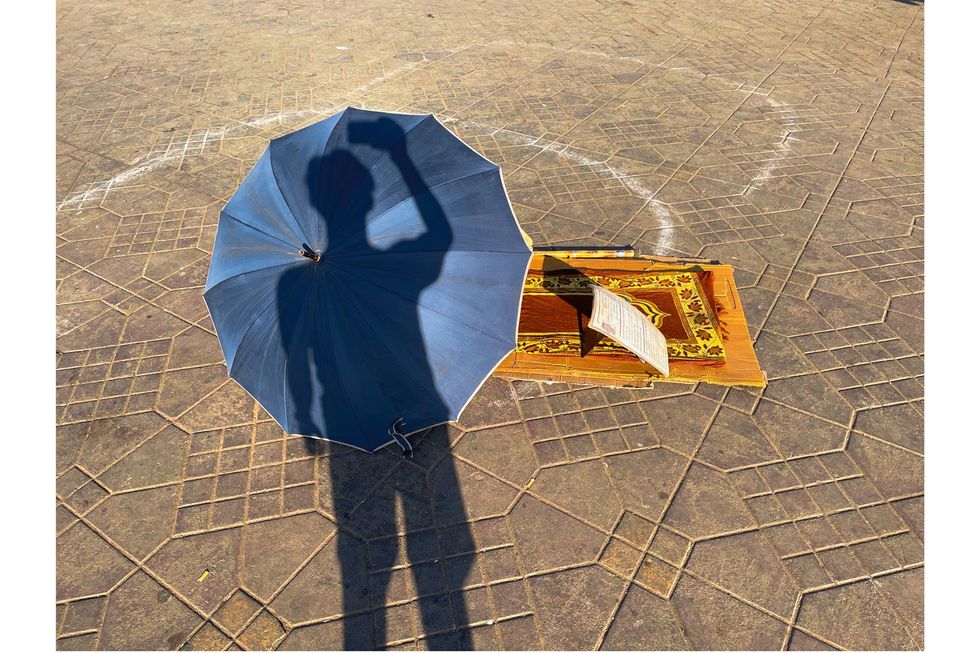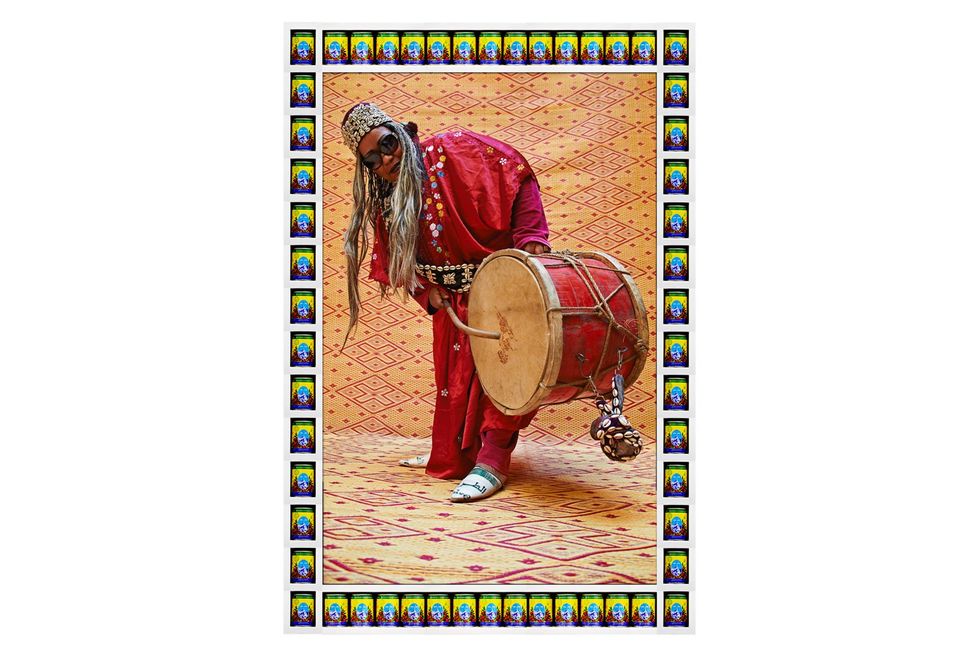Hassan Hajjaj, Godfather of Morocco’s Creative Scene
Through his tea and showrooms, the celebrated photographer and multidisciplinary artist is making space for the younger generation to take the stage.

Hassan Hajjaj portrait by ©Nour Eddine Tilsaghani, 2021/1442.
As OkayAfrica’s North Africa correspondent, I rarely speak to a Moroccan artist who doesn’t praise Hassan Hajjaj at some point in the conversation. The photographer’s presence is all around, credited with helping the new generation kick off their careers and inspiring young Moroccans to immerse themselves in the Red City’s art world.
Interviewing young creatives for an article on reverse migration, an Egyptian Canadian producer called Hajjaj the “godfather of Morocco’s artistic scene,” and a Moroccan artist said he’s “gold in human form.” Naturally, I had to set up a call with Hajjaj and ask him if he’s aware of the impact he has on younger generations.
Hajjaj picked up the phone in London, where he was cutting vegetables. “How are you doing today? Where are you calling from?” he answers, living up to his reputation of being kind and down to earth.
I ask him if he sees himself as a mentor to younger artists; his answer is humble and honest: “You don’t see yourself that way, it’s a compliment. I’ve been in the game for a long time, and I’m doing something that feels correct. If it feels good to my heart, I'll do it.”
Born in Larache, a small fishing village in Morocco, Hajjaj moved to London at the age of twelve and grew up to become a multidisciplinary pioneer of photography. Mixing Moroccan fabrics and bright colors with objects of Western pop culture, he established a signature style that, once you’ve seen, is immediately recognizable.

“Art was really far away from my world when I was younger,” Hajjaj says. “Artists were not what we aspired to, unless it was music. Growing up in council flats, we were very uncomfortable going to galleries and museums.” But Hajjaj loved photography and certain friends helped him enter that realm, so he understands the impact a mentor can have on a young artist’s life.
“Shirin Neshat is a major Iranian artist that I was a big fan of,” he remembers. “Later in my career, when I started being in group shows, all of a sudden, my pictures were hanging there with hers. It was a big thing for me.”
Wanting to share his knowledge and experience, Hajjaj started inviting photographers to showcase their work alongside his, and to hold solo shows in his home studio. “When you do something with the heart, it doesn’t have to be planned, it happens naturally,” he explains.
One of the photographers he invited in 2020 was Ismail Zaidy, whose work explores intimate scenes of human relations and natural landscapes. 3aila (family), held at Hajjaj’s Riad Yima boutique and tea room in the medina of Marrakech, was Zaidy’s first exhibition and he has blown up since.
“Before I met [Hassan], he was a huge inspiration and influence in my career,” Zaidy tells OkayAfrica. “At that time in Morocco, we didn't have any Moroccan examples in photography at the international level. Since I met him, he has always provided me with information and guidance, and he has connected me with people from his circle. He is always here to help.”


Earlier this year, Hajjaj offered both Riad Yima and Jajjah, another tea room and showroom of his, to emerging Moroccan photographer Rida Tabit. As part of 1-54 Art Fair, Tabit exhibited his solo show The Other in the Self as well as his ongoing project Along The Wall in partnership with Hajjaj.
“As an emerging artist from Morocco, I’ve been incredibly lucky to connect and learn from the amazing Hassan Hajjaj,” shares Tabit with OkayAfrica. “He’s a true gem among Moroccan photographers, managing to thrive on the international and local stage for years. It’s super inspiring for us young creatives to see that this kind of success is achievable. And when you get to know him personally, you realize there’s a passionate and kind person behind all this.”

Decades into his artistic practice, the themes Hajjaj raises and subverts in his work — orientalism, colonialism, gender and class roles — are as relevant as ever. Still, there’s an inevitable cultural gap between an established godfather and emerging generations. “My university was traveling and meeting people internationally, but they have the globe in their hands,” Hajjaj says in our phone call.
“At the same time, a lot of these young artists value and understand their culture and home in ways that were not valued in the past. Everything was following the West, but what I like about the younger generation is that they still have their culture embedded in them. You can hear it in music like Afrobeats and see it in fashion when African designers modernize traditional stuff.”
About the future of his art galleries, he shares: “Later on, I want to invite international artists once or twice a year, to fuse the Moroccan community with international artists.”

Hajjaj’s work has always been inspired by music; he used to promote underground club nights, exhibited the critically acclaimed My Rock Stars series, and shot the likes of Cardi B and Billie Eilish. A project he’s been working on for 25 years, but hasn’t showcased yet, is a series of Moroccan Gnawa musicians. Gnawa music is considered both a prayer and a celebration of life that merges African, Berber, and Arabic religious songs and rhythms.
In between Gnawa and Moroccan hip-hop, Hajjaj has hundreds, even thousands of images documenting the music coming out of his home country. “I’ve been listening to a lot of hip-hop, but also Houariyat (women’s bands), Berber music, you know, true music that’s been around for a long time and is part of the culture.”


Before we end our call, I ask Hajjaj what he dreams about. “Peace,” he answers. “With myself and the world and everything else. Now you’re talking to an old person, so peace and health.” With multiple simultaneous exhibitions going on in New York, Saudi Arabia, and soon, the Netherlands, “old” hardly describes this artist with his thriving career and social life.
- Hassan Hajjaj Photographs Moroccan Biker Women In 'Kesh Angels' ›
- Hassan Hajjaj To Premiere Documentary About Badass Moroccan 'Henna Girl' ›
- Hassan Hajjaj's Moroccan Biker Barbie Dolls ›
- In Conversation with Hassan Hajjaj on Artist Solidarity and the Impact of 'La Caravane' ›
- Moroccan Art Galleries Welcome the World at This Year’s 1-54 Art Fair | OkayAfrica ›
- People of My Time: Hassan Hajjaj’s Latest Exhibition Centers Community and Friendship | OkayAfrica ›

